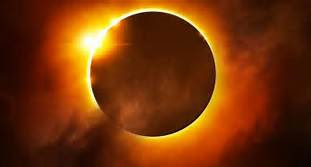On Monday, 21
August 2017, I again witnessed one of the ephemeral fireflies of the cosmos: a total solar eclipse. At my location, 35 crow miles NW of Beatrice,
Nebraska, and less than a mile south of the mid-line of the eclipse totality
band, the total eclipse would last two minutes and 30-plus seconds, only a few
seconds shy of the longest totality anywhere for this eclipse--enough time for
development of the side effects I most wanted to experience: coolness, darkness, quietness of wild
creatures, and the diamond ring.
Age was my
motivation, suggesting that this trip was for me a “last time” concerning this particular event. A total solar eclipse does occur somewhere
across our Earth’s surface every few years, with the next one, on 2 July 2019,
beginning out in the South Pacific and slicing across lower South America. But for us, the next will not occur until 8
April 2024—across northern Mexico and the southern United States. (ed. note: RiverSoul, at 92, will once again experience a solar eclipse.)
I didn’t mind the
Sunday afternoon effort involved in searching out a prime spot in a very rural
setting: a small parking lot serving a primitive boat
ramp along a cattail-lined lake that was the centerpiece of the Swan Lake
Wildlife Management Area. Important were
the relative remoteness and that trees, shrubs, or cattails surrounded the site,
making it both prime bird habitat and a good place to overnight in my
van/camper.
By late morning on
Monday, my chosen spot had begun to experience change. By show time, eight other cars had found this
parking lot. The moon began cutting into
our star. A deepening mid-day dusk shadowed
the cooling air. Vocal cords revealed an
increasing excitement. Red-winged blackbirds and marsh wrens, usually busy in
and around the cattails, were becoming less active. The number of bank swallows slicing air in
pursuit of insects was decreasing. Soon
there were none.
When the moon
snapped shut that last rim of sun, a sharp drop in visibility occurred; I could
not read a license plate 30 feet away. The air became cooler, faster. The sun’s
corona glowed full around, and a deep, spiritual quietness settled over both
people and land. Our totality gave us sufficient
time to absorb a good dose of humility. But, aware of dire forecasts associated with
the approaching storm “Harvey,” I was conflicted.
As the spheres
moved on--the sun’s corona still in view--a piece of sun rim flashed free from
behind the moon’s trailing edge, giving us a beautiful, but ephemeral,
celestial diamond ring. While the two
spherical bodies moved apart, the insight arose that none of us had the
slightest measure of control over any of what we had just seen.
Then came the
realization that that ring stood for us.
For each of the countless thousands of us who watched the shadow of that
ephemeral celestial union racing eastward across our great and troubled land. For each of us, during our own period of darkness,
as we symbolically joined hands and hearts to share a moment of wonderment.
Elder RiverSoul
RIVERSOUL is a native Kansan and retired emeritus professor of biology. In addition to research on mammals and reptiles, he has published essays on the dangers of pollution. His scientific and creative nonfiction essays have appeared in scientific journals and literary journals. He will be 93 years old in May 2024 and continues to publish articles.
first published on 9/13/17; reposted 4/4/24
Please follow us on Facebook
Contact us if you would like to receive email updates or submit your original work.




No comments:
Post a Comment